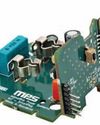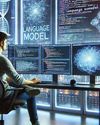Bend, Fold, And Stretch: The Rise Of PRINTABLE ELECTRONICS
Electronics For You
|March 2025
Flexible electronics are already reshaping the present. As innovation accelerates, India is set to lead in scalable, sustainable production. The question is not if but how soon they will redefine our world.

The next generation of technology is flexible. Devices that bend and stretch without compromising performance are transforming healthcare, consumer electronics, and beyond. The most visible example? Foldable smartphones. But the scope of flexible tech extends far beyond that, spanning wearables, healthcare innovations, smart packaging, and much more.
At the forefront of this revolution is printable electronics, where circuits are printed like ink on paper, creating scalable and cost-effective solutions for a more adaptable future.
How do printable electronics work?
So, what makes printable electronics so special? It all begins with conductive inks, which use nanoparticles of silver, copper, or carbon to create circuits on substrates such as paper, fabric, or flexible plastic. These materials are far more flexible than traditional ones, allowing for electronics that bend and stretch. Polymer technology also plays a major role, providing versatile materials that can serve as conductors, semiconductors, or insulators. This flexibility, combined with roll-to-roll printing techniques, helps bring down costs while scaling production, paving the way for mass-produced, adaptable electronics.
Innovations in nanotechnology, including graphene and self-healing polymers, enhance durability and device functionality. Self-healing materials are especially valuable for wearables, which demand resilience for daily use. Meanwhile, advancements in thin-film transistors (TFTs) and organic light emitting diodes (OLEDs) improve performance and lower costs, making flexible displays more accessible.
 India's emerging leadership in flexible electronics
India's emerging leadership in flexible electronicsDit verhaal komt uit de March 2025-editie van Electronics For You.
Abonneer u op Magzter GOLD voor toegang tot duizenden zorgvuldig samengestelde premiumverhalen en meer dan 9000 tijdschriften en kranten.
Bent u al abonnee? Aanmelden
MEER VERHALEN VAN Electronics For You

Electronics For You
Tech Majors Are Racing TOWARDS NET-ZERO - What About You?
Apple, Microsoft, Amazon, Google, Infosys, Wipro—global and Indian firms are heading closer to achieving net-zero emissions, a mandate to combat climate change. Here is what you need to know to start your journey...
12 mins
December 2025

Electronics For You
Miniature IoT WATER TDS And LEVEL MONITOR Cum CONTROLLER
For setups that rely on stored water, clear awareness of tank level and water quality is essential.
3 mins
December 2025

Electronics For You
The Impact Of GENERATIVE AI On The Future Of AUTOMOTIVE AND EVs
Autonomous vehicles, connected ecosystems, and smart factories are only the beginning. Generative Al is pushing the auto industry beyond predictions into a bold era of creativity-from EV design to real-time diagnostics and showroom automation. Here is how GenAl is reshaping innovation across the automotive value chain.
8 mins
December 2025

Electronics For You
How AI Tools Are Making SOFTWARE DEVELOPMENT BETTER
AI is reshaping how we code, debug, and collaborate. From Copilot to automation, it is changing software development in ways worth exploring.
3 mins
December 2025
Electronics For You
How AI Tools Are Making SOFTWARE DEVELOPMENT BETTER
AI is reshaping how we code, debug, and collaborate. From Copilot to automation, it is changing software development in ways worth exploring.
3 mins
December 2025

Electronics For You
5 Interesting Reference Designs FOR SMART HOMES
Smart home devices are transforming the way people interact with their appliances. They make homes more convenient, secure, and energy-efficient. From smart plugs and energy monitors to smart locks and thermostats, reference designs help design engineers create connected products that are easy to use, consume less power, and are reliable. These designs allow you to control devices remotely, track energy use, extend battery life, and automate routines. They provide practical solutions for upgrading homes and small commercial spaces without major modifications.
3 mins
December 2025

Electronics For You
Fancy USB LED VASE
This USB LED vase is a simple yet elegant device that fuses art with electronics to create a decorative lighting display. Powered directly from a standard USB port, it uses readily available components such as MOSFETs, resistors, capacitors, and LEDs to produce a striking, dynamic sequence of lights.
3 mins
December 2025

Electronics For You
"WHAT OTHERS SELL IN FOUR BOXES WE BUILT IN ONE"
Years of custom field work are shaping a product line with its own cloud, its own hardware, and a market that is now beginning to recognise its value.
8 mins
December 2025

Electronics For You
BUILD LARGE LANGUAGE MODELS
Large language models are machine learning models designed for a range of language-related tasks such as text generation and translation. Here’s how open source software can help you build your own large language model.
6 mins
December 2025

Electronics For You
Rare Earth Or Rare Ingenuity? India Remains Between The Two
With China firmly controlling rare earth exports, India confronts a critical moment in its technological trajectory.
8 mins
December 2025
Listen
Translate
Change font size

